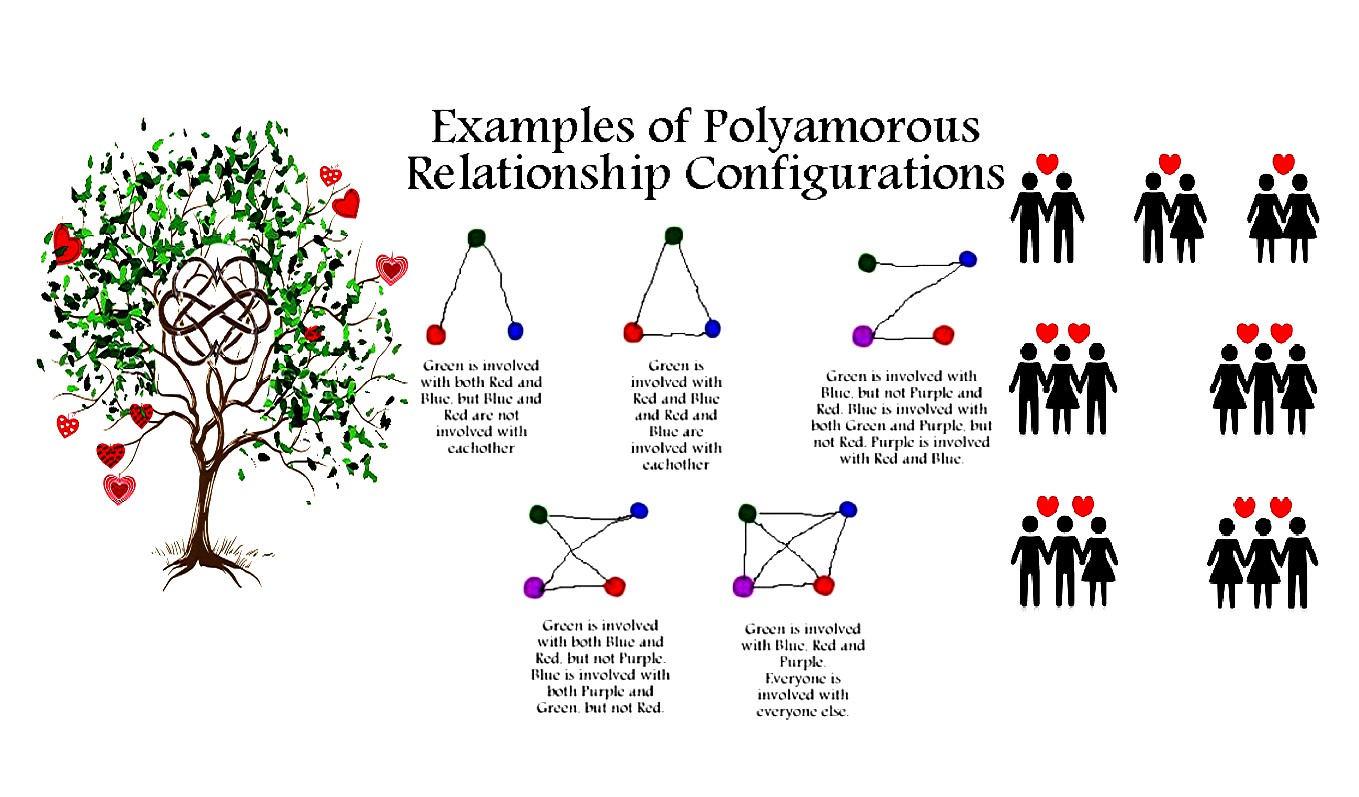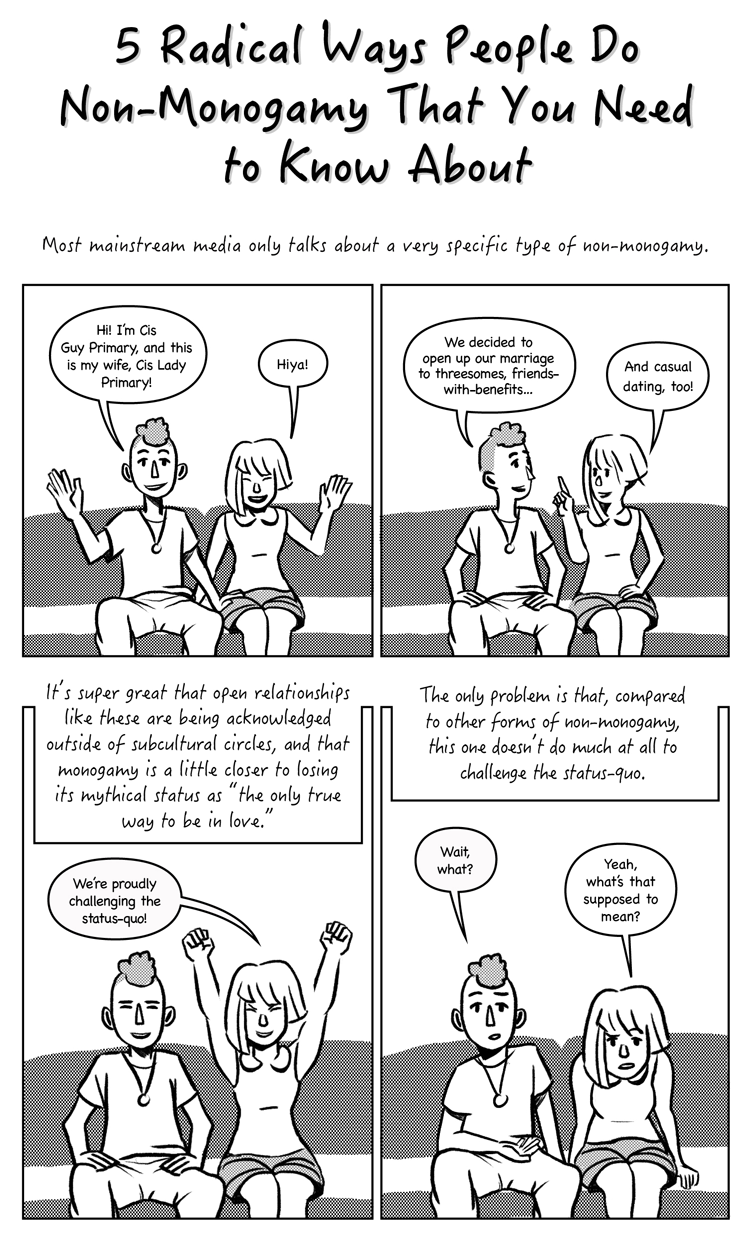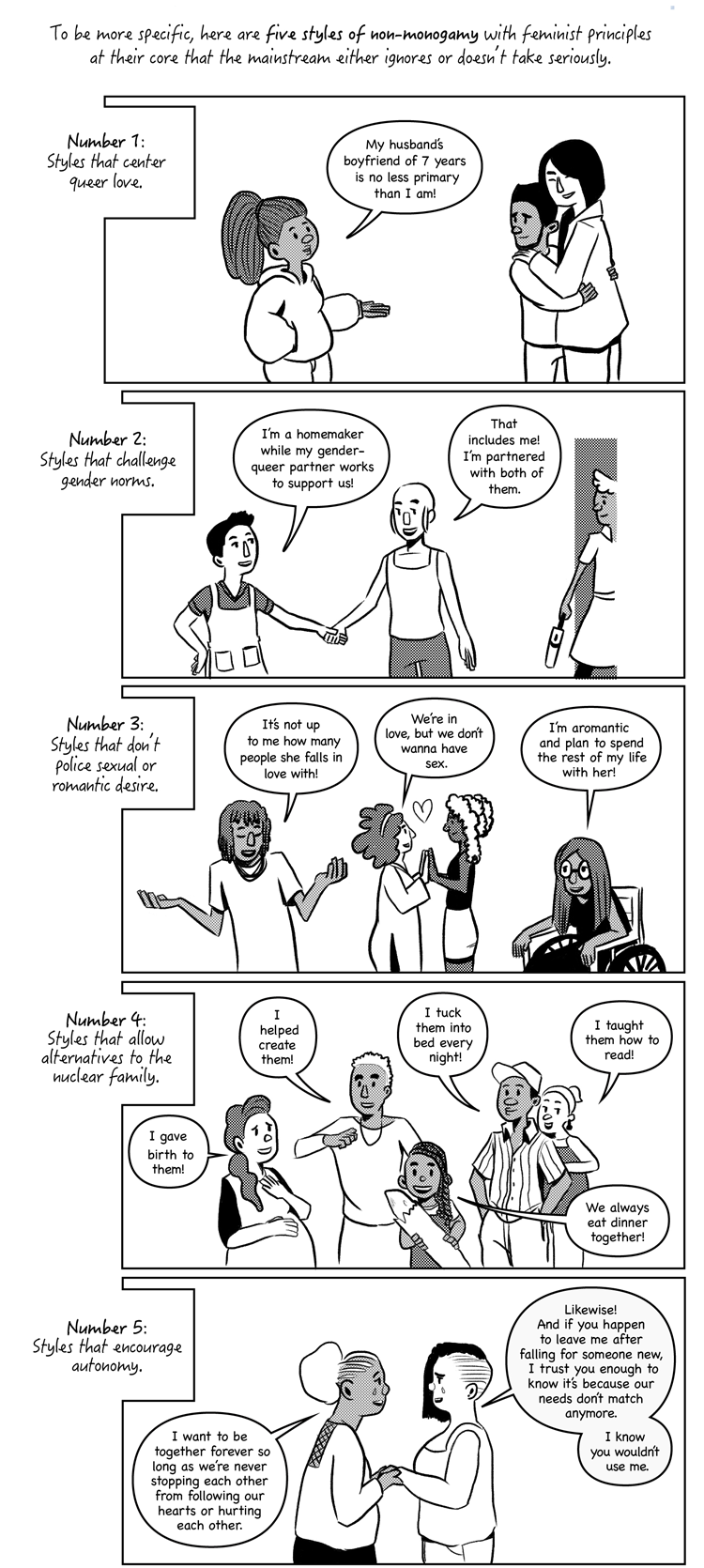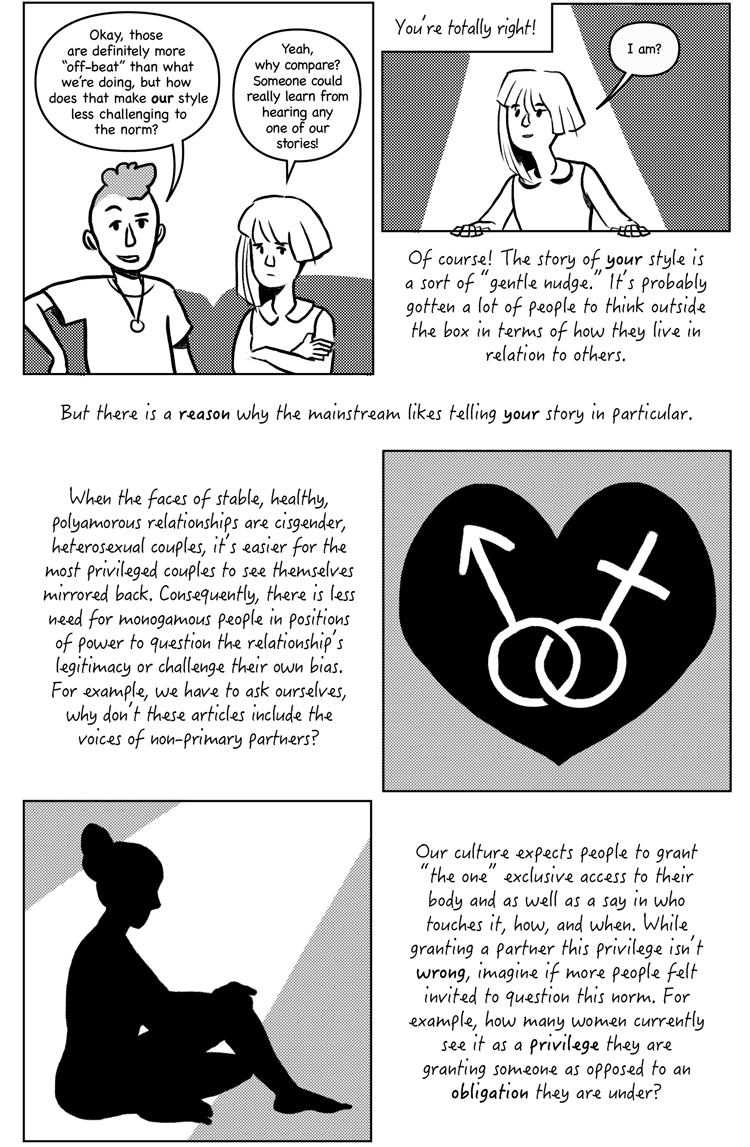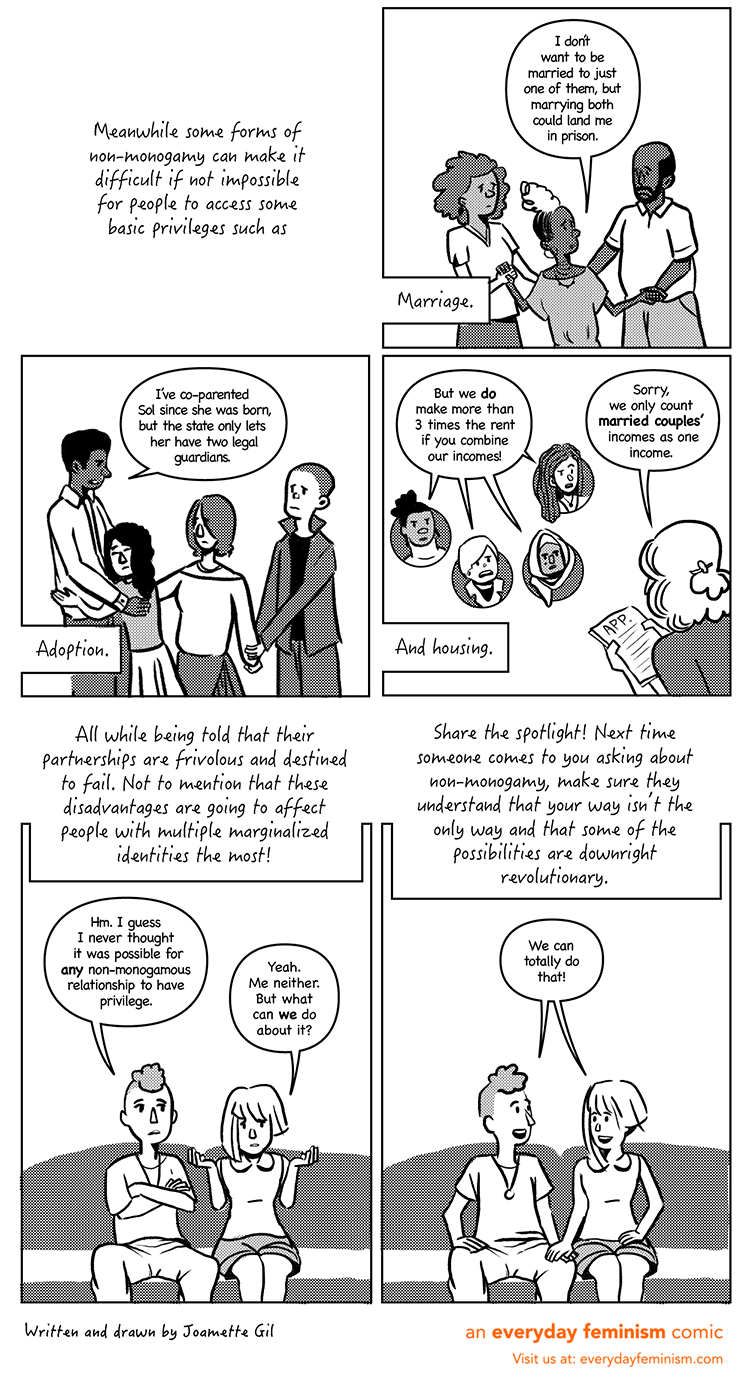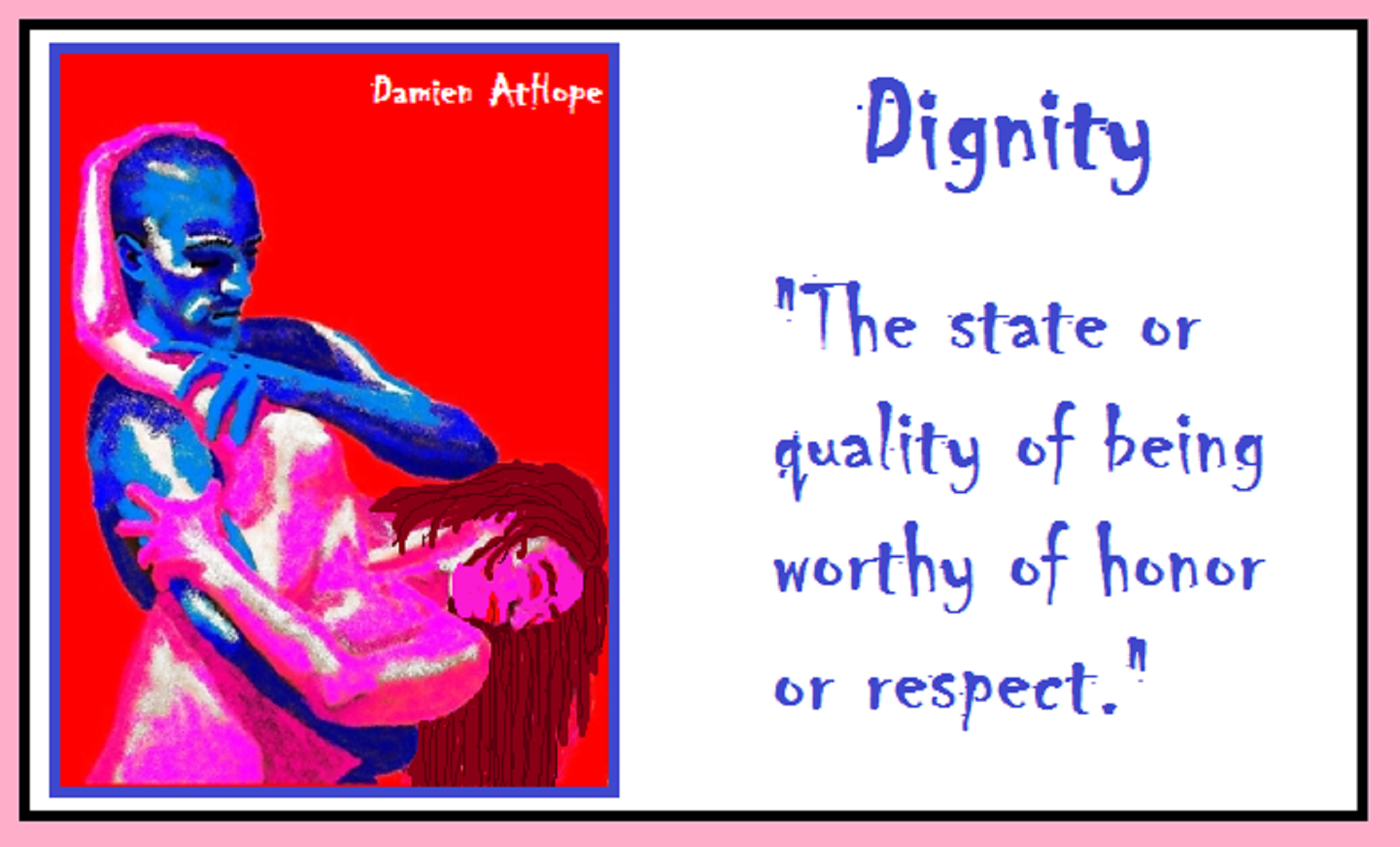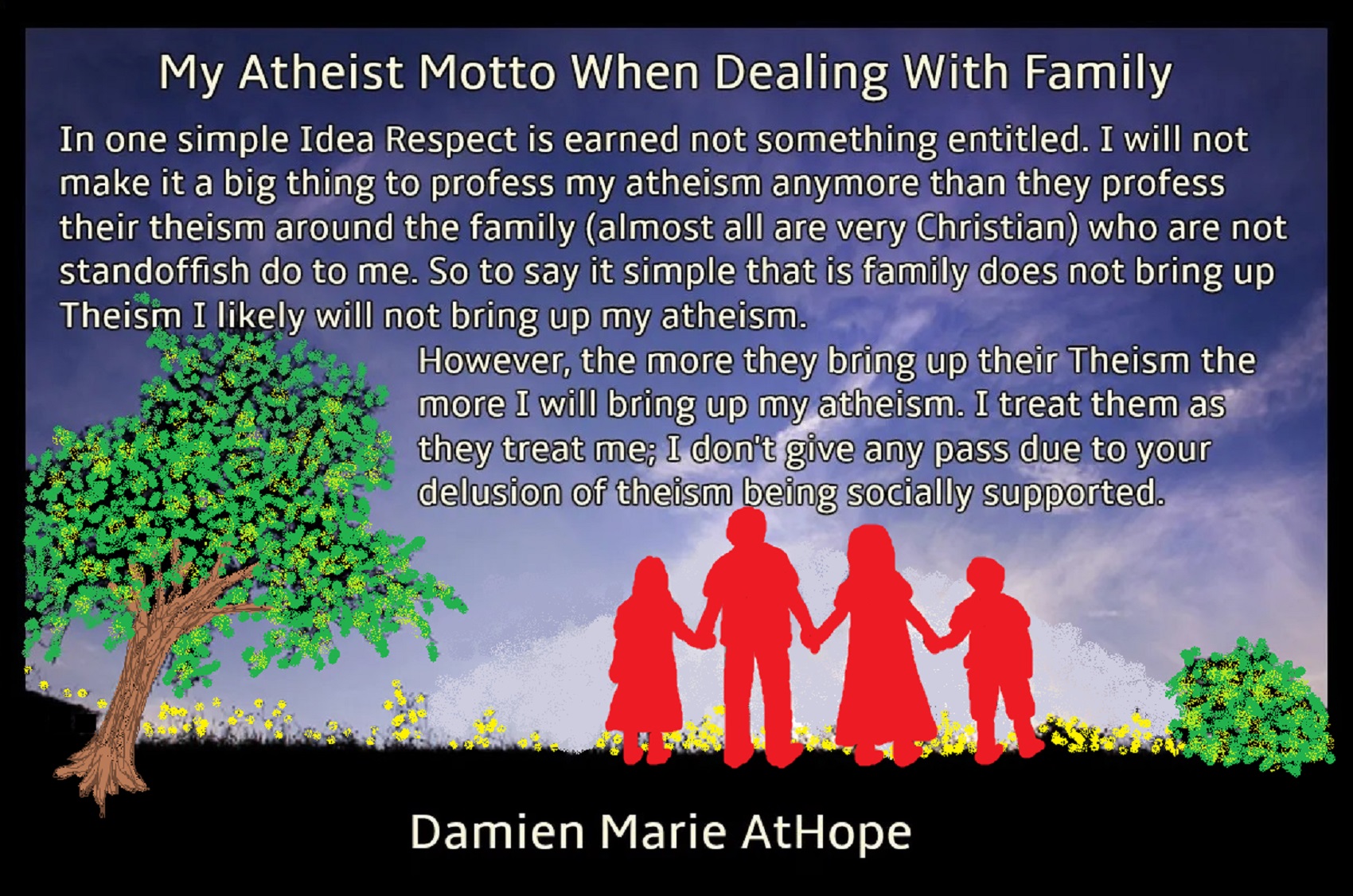Liberty, Liking/Love, Jealousy, Respect and Loyal in Poly or Non-Monogamy?
“Damien, I’m interested in non-monogamy right now, I’m tired of failed relationships. I’m trying something new with this man I’ve met and that I really like. I think he’s seeing other women. That’s not a bad thing. Right? I’m trying to understand. I like him but I’m trying to overcome this feeling of why he feels the need to go elsewhere. I’m just learning. I’m tired of feeling jealous. I’m Interested in Learning More About Polygamy.”
Here are three of my blogs on non-monogamy/poly:
- Atheist for Non-monogamy: For Open Hearts and Open Minds
- Lovestyle or Lifestyle Options
- Personhood Explored
I am not a vary jealous person as it’s a fear of loss and I don’t own people. I can be hurt how people respect or disrespect me regardless of what relationship dynamic even a one night stand should be respectful and honoring to me. love is love. So, it is better to think in terms of respect or disrespect not really about being jealous or non-jealous.
We often may be apprehensive to start any relationship as we are not sure, but we can never be completely sure of almost any relationships. We can love and be open to being loved, that is pretty much it, no guarantee.
“Damien, he may be a term that I can’t remember. A womanizer that wants the women to have sex with only him? I say that because he asked me if I was being loyal to him, I’m like hmmm?”
Well womanizer, to me, is a liar that cons women into sex, with no care for them, as he may say “things” only wanting to use them and discard them at his whim without regard for the sex partners as fellow beings of dignity deserving open respect…
“Damien, yea. We’re gonna have a long talk. I don’t know him very well. Just seen him twice.”
Well, being loyal in poly (Polyfidelity also sometimes called polyexclusivity) could also mean a few different things: polyexclusivity
Polyexclusivity is a form of polyamory where all partners or members are considered equal partners and agree to be sexually active only with other partners or members of the group. Polyfidelity also sometimes called polyexclusivity, because the term polyexclusivity can clarify misunderstandings relating to the multiple meanings of ‘fidelity’. There are many polyamorous groups who are fidelitous or faithful to themselves but who are also open to new sexual/romantic relationships. In these cases, the term polyfidelity can be misleading.
Fluid fidelity, is commonly cited advantage of this form of polyamory is the ability to fluid bond among more than two people while maintaining relative safety regarding STDs, so long as any new members are sufficiently tested before fluid bonding with the group, and keep their commitments. This would have health advantages similar to monogamy, although risks rise somewhat with each person added.
Emotional fidelity, when partners expect that deep feelings are not cultivated or allowed with unpartnered poly members or partners or where others may prefer emotional safety from the relatively closed nature of the polyfaithful commitment.
For some people, polyfidelity, like polyamory, is an identity, not a choice or an action.
Polyfaithful relationships are, like monogamous relationships, closed in the sense that partners agree not to be sexual outside the current members of the group. The difference is that more than two people are included in the closed group. New members may generally be added to the group only by unanimous consensus of the existing partners or members, or the group may not accept new members.
Some polyamorous people desire more flexibility than polyfidelity provides. For example, open relationships do not restrict sexual and emotional bonding in these ways. Some polyamorous people also report that it is difficult to find partners who are mutually compatible enough to form committed group marriages like polyfidelity. Ref
5 Radical Ways People Do Non-Monogamy That You Need to Know About
by Joamette Gil
You might know about the type of non-monogamy that gets most mainstream media attention. But do you know about these other relationship styles outside the status quo? This comic sheds light on the types of non-monogamy that tend to get ignored. Whether non-monogamy’s for you or not, you can probably learn something from these examples of how people create options to put feminist values at the core of their relationships and reject oppressive expectations.
Do they challenge what you think a healthy partnership means?
Exploring the wide world of extra-dyadic sexual relationships.
July 22, 2014 by Elisabeth A. Sheff Ph.D., CASA, CSE Elisabeth A. Sheff Ph.D., CASA, CSE
(Author of) The Polyamorists Next Door: Inside Multiple-Partner Relationships and Families
In contemporary US culture, monogamy means two people agreeing to have sex only with each other and no one else. Classical monogamy – a single relationship between people who marry as virgins, remain sexually exclusive their entire lives, and become celibate upon the death of the partner – has been replaced by serial monogamy – a cycle in which people are sexually exclusive with each other for a period of time, break up, and then re-partner in another sexually exclusive relationship with a different person.
Non-monogamies, in contrast, are more diverse and vary by degrees of honesty, sexual openness, importance of rules/structure, and emotional connection. People who have non-monogamous relationships in the United States range from religious practitioners of polygyny involved in Islam or the Fundamentalist Latter Day Saints (Mormons) who are often personally and politically conservative, to practitioners of polyamory or relationship anarchy who tend to be personally and politically liberal or progressive. Especially among the more liberal groups, there is significant overlap with other unconventional subcultures such as Pagans, geeks, gamers, science fiction enthusiasts, and practitioners of BDSM (previously known as sadomasochism, also termed kinky sex or kinksters).
Cheating
Some people see any non-monogamous relationship as adulterous, regardless of whether or not both partners have consented to having sexual interactions outside the committed couple. I argue that transparency matters, and consensual non-monogamy (CNM) is qualitatively different from non-consensual non-monogamy, or cheating. The two relationship categories also have distinctly different outcomes for the people involved: not only do consensual non-monogamists try to tell each other the truth, but this greater communication has real impacts, such as greater rates of STI transmission among non-consensual non-monogamists than among consensual non-monogamists. Many non-monogamists rely on honest communication to negotiate consensual agreements that allow a variety of ways to have multiple partners.
Even though contemporary society agrees that cheating is undesirable, people still do it regularly. Scholars estimate that approximately 20-25 percent of ever-married men and 10-15 percent of ever-married women admit to having an affair at some point in their relationship. Cheating has gotten easier, as technology has expanded opportunities for infidelity by helping us find our old high school crushes on Facebook or casual encounters on Craigslist and OKCupid. Defining cheating can be quite difficult because it may include a wide variety of behaviors that are not directly physical sex, from sending virtual flowers to video chatting on Skype, or a “chaste” lunch date with no physical contact but an emotionally intimate conversation fraught with repressed passion to paid phone sex with a professional.
Polygamy
Alongside (and even predating) monogamy, cultures throughout the world have long practiced polygamy — a form of marriage consisting of more than two persons. The most common form of multiple partner marriage is polygyny, a marriage of one husband and multiple wives who are each sexually exclusive with the husband. Worldwide, Muslims are those who are most likely to be polygynous, with the highest concentrations of contemporary polygyny in the Middle East and parts of Africa. Polyandry –a marriage of one wife to multiple husbands — is far more rare, as marriages between one woman and multiple men have received less social, political, and cultural support than have polygynous relationships.
Open
Open relationships are varied enough to be an umbrella term for consensually non-monogamous relationships based on a primary couple who are “open” to sexual contact with others. The most common form of open relationship is that of a married or long-term committed couple that takes on a third (or sometimes forth or fifth) partner whose involvement and role in the relationship is always secondary. A couple practicing this relationship type might engage in sexual activity with the secondary partner together or separate, or they may each have independent outside relationships with different secondary partners—regardless of the specific parameters, the primary couple always remains a priority. Generally rooted in specific rules, expectations, and communication between those involved, open relationships may take a variety of forms and may evolve over time as needed to meet the needs of those persons involved. Swinging, monogamish, polyamorous/polyfidelitous, and anarchistic relationships can all be considered “open.”
Swinging
Among recognized or intentional forms of non-monogamy, swinging is the best known and most popular. Most broadly, swinging involves committed couples consensually exchanging partners specifically for sexual purposes. It is tremendously diverse, ranging from brief interactions between or among strangers at sex parties or clubs, to groups of friends who know each other and socialize for many years. Begun as the practice of “wife swapping” among US Air Force pilots after World War II, swinging has spread across the globe and become quite popular on the Internet. Generally a heterosexually-focused sub-culture, swingers have a reputation for being much more open to “girl on girl” same-sex interaction but often explicitly reject sexual contact between men at swing clubs or parties.
Monogamish
Popularized within the last few years by Dan Savage, monogamish relationships are those in which a couple is primarily monogamous but allows varying degrees of sexual contact with others. As with other non-monogamies, rules structuring these external sexual contacts vary by couple: Some allow only one-night stands (no second time with the same person) or only specific kinds of sexual activity (ie. kissing and groping are OK but no intercourse) and others have time (no more than a week) or location limitations (only when people are traveling or not at home).
Polyamory and Polyfidelity
Polyamory is a relationship style that allows people to openly conduct multiple sexual and/or romantic relationships simultaneously, ideally with the knowledge and consent of all involved in or affected by the relationships. Polyfidelity is similar except that it is a closed relationship style that requires sexual and emotional fidelity to an intimate group that is larger than two. Polyaffective relationships are emotionally intimate, non-sexual connections among people connected by a polyamorous relationship, such as two heterosexual men who are both in sexual relationships with the same women and have co-spousal or brother-like relationships with each other.
Relationship Anarchy
Given the anarchist nature of this relationship philosophy, it is difficult to pin down an exact definition of relationship anarchy (RA), but two themes appear regularly in the writings of people who discuss it. First, relational anarchists are often highly critical of conventional cultural standards that prioritize romantic and sex-based relationships over non-sexual or non-romantic relationships. Instead, RA seeks to eliminate specific distinctions between or hierarchical valuations of friendships versus love-based relationships, so that love-based relationships are no more valuable than are platonic friendships. Each relationship is unique and can evolve as participants require; if conflict arises, people deal with the issues or the relationship comes to an end. Because love is abundant, people can have many concurrent meaningful and loving relationships that are not limited to the couple format. Second, another important theme within RA is the resistance to placing demands or expectations on the people involved in a relationship. Whereas swingers and polyamorists often create specific rules and guidelines to structure their relationships, RA rejects such rules as inevitably leading to a hierarchical valuation of some partners over others. In RA, no one should have to give anything up or compromise in order to sustain a relationship; rather, it is better to amicably separate than to sustain an unhappy and unfulfilling relationship. Ref
From the Polyamory Society,
Polyamory has its own unique multipartner terminology and language. One of the most popular styles of Polyamory is Polyfidelity. Sometimes also called closed group marriage. In Polyfidelity, groups of three or more partners consider themselves essentially married to each other. They usually live together in a single home and share their lives and resources such as married couples do. There may be any combination of males, females and sexual orientations. Polygyny, as it was practiced by the Mormons, is just one example of Polyfidelity. Classically, Polyfidelitous groups are sexually exclusive and do not engage in sexual relations outside the group. However, there are some group marriages which are “open,” and which do allow for outside eromances. In the open marriage style relationships in which the members who consider themselves committed life partners nonetheless permit outside, sexual, romantic and loving relationships outside the marriage in a way that is agreed upon by the marital partners. Some, but by no means all, “intentional communities” follow Polyamorous principles. The residents of the community may think of themselves as all “married” to each other (like the Oneida community in nineteenth century New York State) or not, but all members of the community may be viewed as legitimately available to each other as sexual and/or romantic partners (like the ZEGG community in present-day Germany or Windward in Washington state). Others have found Polyamory through residing in group homes and through cooperative housing living arrangements. Finally at the less structured end of the spectrum are Intimate Networks. They are informal webs of people with varying levels of interpersonal bonding and commitment who share a belief in open multilateral relationships. Intimate Networks often develop around or among open marriages or open couples. People in Intimate Networks and other Polyamorous relationships sometimes refer to the depth of their relationships as “Primary,” “Secondary,” and “Tertiary” to describe the varying levels of commitment involved.
Primary Relationships are the closest relationship type, the person(s) given the most time, energy and priority in a person’s life; includes high level of intimacy, attraction and commitment as demonstrated by marriage-level bonding (such as shared life paths, goals, parenting, economics, housing, important values, ongoing emotional support, etc.) Typically includes a desire for a shared lifelong future together.
Secondary Relationships are close relationship types, by definition they are given less in terms of time, energy and priority in a person’s life than any primary relationship. Includes aspects of primary relating, such as sexuality and emotional support but usually involves fewer ongoing commitments as evidenced by fewer shared values, plans or financial/legal involvements. May include a desire for a long term future together.
Tertiary Relationships are relationships which may include emotional support or sexuality on a one-time or highly erratic schedule. Attention or energy is given in bursts but the relationship(s) is not a consistent part of one’s life. Ref
My response, well, jealousy to me is the fear of loss, a very natural feeling. So, I focus on the feeling I don’t own people and still may ones in a while feel a threat of loss but all of life is a threat of loss thus I try to put it in such perspectives and if I still am bothered I talk about my feelings and try to let myself ok to sometimes not feel god all the time. All of life is managing feelings and that is true even when single, married or open married. I would advise trying nudist without sex first to allow you to test the water first to allow yourself to acclimate.
“We were thinking exhibitionism (sex in front of people at club or something.) is that a bad idea? I guess it may not be polyamory as your article describes. It’s sexual in nature, but we want to be in a relationship with each other.” – Questioner
My response, I would try nude no sex first then if you feel good try the sex in public or something else I think it is easy to jump in fast which is good for some but most are better served to just go slow as you want to keep the relationship you have and just add more fun things to it.
“Yeah, that is a good point.” – Questioner

While hallucinogens are associated with shamanism, it is alcohol that is associated with paganism.
The Atheist-Humanist-Leftist Revolutionaries Shows in the prehistory series:
Show two: Pre-animism 300,000 years old and animism 100,000 years old: related to “Anarchism and Socialism”
Show tree: Totemism 50,000 years old: related to “Anarchism and Socialism”
Show four: Shamanism 30,000 years old: related to “Anarchism and Socialism”
Show five: Paganism 12,000 years old: related to “Anarchism and Socialism”
Show six: Emergence of hierarchy, sexism, slavery, and the new male god dominance: Paganism 7,000-5,000 years old: related to “Anarchism and Socialism” (Capitalism) (World War 0) Elite and their slaves!
Prehistory: related to “Anarchism and Socialism” the division of labor, power, rights, and recourses: VIDEO
Pre-animism 300,000 years old and animism 100,000 years old: related to “Anarchism and Socialism”: VIDEO
Totemism 50,000 years old: related to “Anarchism and Socialism”: VIDEO
Shamanism 30,000 years old: related to “Anarchism and Socialism”: VIDEO
Paganism 12,000 years old: related to “Anarchism and Socialism” (Pre-Capitalism): VIDEO
Paganism 7,000-5,000 years old: related to “Anarchism and Socialism” (Capitalism) (World War 0) Elite and their slaves: VIEDO
Paganism 5,000 years old: progressed organized religion and the state: related to “Anarchism and Socialism” (Kings and the Rise of the State): VIEDO
Paganism 4,000 years old: related to “Anarchism and Socialism” (First Moralistic gods, then the Origin time of Monotheism): VIEDO
I do not hate simply because I challenge and expose myths or lies any more than others being thought of as loving simply because of the protection and hiding from challenge their favored myths or lies.
The truth is best championed in the sunlight of challenge.
An archaeologist once said to me “Damien religion and culture are very different”
My response, So are you saying that was always that way, such as would you say Native Americans’ cultures are separate from their religions? And do you think it always was the way you believe?
I had said that religion was a cultural product. That is still how I see it and there are other archaeologists that think close to me as well. Gods too are the myths of cultures that did not understand science or the world around them, seeing magic/supernatural everywhere.
I personally think there is a goddess and not enough evidence to support a male god at Çatalhöyük but if there was both a male and female god and goddess then I know the kind of gods they were like Proto-Indo-European mythology.
This series idea was addressed in, Anarchist Teaching as Free Public Education or Free Education in the Public: VIDEO
Our 12 video series: Organized Oppression: Mesopotamian State Force and the Politics of power (9,000-4,000 years ago), is adapted from: The Complete and Concise History of the Sumerians and Early Bronze Age Mesopotamia (7000-2000 BC): https://www.youtube.com/watch?v=szFjxmY7jQA by “History with Cy“
Show #1: Mesopotamian State Force and the Politics of Power (Samarra, Halaf, Ubaid)
Show #2: Mesopotamian State Force and the Politics of Power
Show #3: Mesopotamian State Force and the Politics of Power (Uruk and the First Cities)
Show #4: Mesopotamian State Force and the Politics of Power (First Kings)
Show #5: Mesopotamian State Force and the Politics of Power (Early Dynastic Period)
Show #6: Mesopotamian State Force and the Politics of Power
Show #7: Mesopotamian State Force and the Politics of Power (Sargon and Akkadian Rule)
Show #9: Mesopotamian State Force and the Politics of Power (Gudea of Lagash and Utu-hegal)
Show #12: Mesopotamian State Force and the Politics of Power (Aftermath and Legacy of Sumer)

The “Atheist-Humanist-Leftist Revolutionaries”
Cory Johnston ☭ Ⓐ Atheist Leftist @Skepticallefty & I (Damien Marie AtHope) @AthopeMarie (my YouTube & related blog) are working jointly in atheist, antitheist, antireligionist, antifascist, anarchist, socialist, and humanist endeavors in our videos together, generally, every other Saturday.
Why Does Power Bring Responsibility?
Think, how often is it the powerless that start wars, oppress others, or commit genocide? So, I guess the question is to us all, to ask, how can power not carry responsibility in a humanity concept? I know I see the deep ethical responsibility that if there is power their must be a humanistic responsibility of ethical and empathic stewardship of that power. Will I be brave enough to be kind? Will I possess enough courage to be compassionate? Will my valor reach its height of empathy? I as everyone, earns our justified respect by our actions, that are good, ethical, just, protecting, and kind. Do I have enough self-respect to put my love for humanity’s flushing, over being brought down by some of its bad actors? May we all be the ones doing good actions in the world, to help human flourishing.
I create the world I want to live in, striving for flourishing. Which is not a place but a positive potential involvement and promotion; a life of humanist goal precision. To master oneself, also means mastering positive prosocial behaviors needed for human flourishing. I may have lost a god myth as an atheist, but I am happy to tell you, my friend, it is exactly because of that, leaving the mental terrorizer, god belief, that I truly regained my connected ethical as well as kind humanity.
Cory and I will talk about prehistory and theism, addressing the relevance to atheism, anarchism, and socialism.
At the same time as the rise of the male god, 7,000 years ago, there was also the very time there was the rise of violence, war, and clans to kingdoms, then empires, then states. It is all connected back to 7,000 years ago, and it moved across the world.
Cory Johnston: https://damienmarieathope.com/2021/04/cory-johnston-mind-of-a-skeptical-leftist/?v=32aec8db952d
The Mind of a Skeptical Leftist (YouTube)
Cory Johnston: Mind of a Skeptical Leftist @Skepticallefty
The Mind of a Skeptical Leftist By Cory Johnston: “Promoting critical thinking, social justice, and left-wing politics by covering current events and talking to a variety of people. Cory Johnston has been thoughtfully talking to people and attempting to promote critical thinking, social justice, and left-wing politics.” http://anchor.fm/skepticalleft
Cory needs our support. We rise by helping each other.
Cory Johnston ☭ Ⓐ @Skepticallefty Evidence-based atheist leftist (he/him) Producer, host, and co-host of 4 podcasts @skeptarchy @skpoliticspod and @AthopeMarie
Damien Marie AtHope (“At Hope”) Axiological Atheist, Anti-theist, Anti-religionist, Secular Humanist. Rationalist, Writer, Artist, Poet, Philosopher, Advocate, Activist, Psychology, and Armchair Archaeology/Anthropology/Historian.
Damien is interested in: Freedom, Liberty, Justice, Equality, Ethics, Humanism, Science, Atheism, Antiteism, Antireligionism, Ignosticism, Left-Libertarianism, Anarchism, Socialism, Mutualism, Axiology, Metaphysics, LGBTQI, Philosophy, Advocacy, Activism, Mental Health, Psychology, Archaeology, Social Work, Sexual Rights, Marriage Rights, Woman’s Rights, Gender Rights, Child Rights, Secular Rights, Race Equality, Ageism/Disability Equality, Etc. And a far-leftist, “Anarcho-Humanist.”
I am not a good fit in the atheist movement that is mostly pro-capitalist, I am anti-capitalist. Mostly pro-skeptic, I am a rationalist not valuing skepticism. Mostly pro-agnostic, I am anti-agnostic. Mostly limited to anti-Abrahamic religions, I am an anti-religionist.
To me, the “male god” seems to have either emerged or become prominent around 7,000 years ago, whereas the now favored monotheism “male god” is more like 4,000 years ago or so. To me, the “female goddess” seems to have either emerged or become prominent around 11,000-10,000 years ago or so, losing the majority of its once prominence around 2,000 years ago due largely to the now favored monotheism “male god” that grow in prominence after 4,000 years ago or so.
My Thought on the Evolution of Gods?
Animal protector deities from old totems/spirit animal beliefs come first to me, 13,000/12,000 years ago, then women as deities 11,000/10,000 years ago, then male gods around 7,000/8,000 years ago. Moralistic gods around 5,000/4,000 years ago, and monotheistic gods around 4,000/3,000 years ago.
To me, animal gods were likely first related to totemism animals around 13,000 to 12,000 years ago or older. Female as goddesses was next to me, 11,000 to 10,000 years ago or so with the emergence of agriculture. Then male gods come about 8,000 to 7,000 years ago with clan wars. Many monotheism-themed religions started in henotheism, emerging out of polytheism/paganism.

Damien Marie AtHope (Said as “At” “Hope”)/(Autodidact Polymath but not good at math):
Axiological Atheist, Anti-theist, Anti-religionist, Secular Humanist, Rationalist, Writer, Artist, Jeweler, Poet, “autodidact” Philosopher, schooled in Psychology, and “autodidact” Armchair Archaeology/Anthropology/Pre-Historian (Knowledgeable in the range of: 1 million to 5,000/4,000 years ago). I am an anarchist socialist politically. Reasons for or Types of Atheism
My Website, My Blog, & Short-writing or Quotes, My YouTube, Twitter: @AthopeMarie, and My Email: damien.marie.athope@gmail.com

